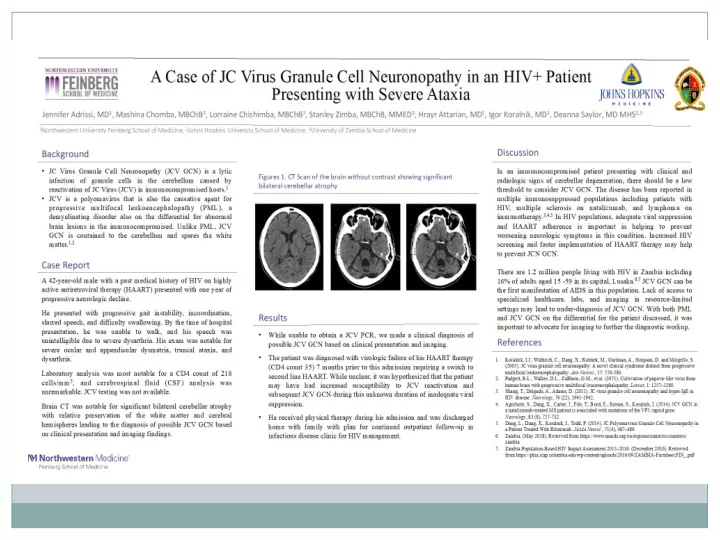

Background JC Virus Granule Cell Neuronopathy (JCV GCN) is a lytic • infection of granule cells in the cerebellum caused by reactivation of JC Virus (JCV) in immunocompromised hosts. 1 JCV is a polyomavirus that is also the causative agent for • progressive multifocal leukoencephalopathy (PML), a demyelinating disorder also on the differential for abnormal brain lesions in the immunocompromised. Unlike PML, JCV GCN is contained to the cerebellum and spares the white matter. 1,2
Case Presentation A 42-year-old male with a past medical history of HIV on highly active antiretroviral therapy (HAART) presented with one year of progressive neurologic decline. He presented with progressive gait instability, incoordination, slurred speech, and difficulty swallowing. By the time of hospital presentation, he was unable to walk, and his speech was unintelligible due to severe dysarthria. His exam was notable for severe ocular and appendicular dysmetria, truncal ataxia, and dysarthria. Laboratory analysis was most notable for a CD4 count of 218 cells/mm 3 , and cerebrospinal fluid (CSF) analysis was unremarkable. JCV testing was not available.
CT Brain without Contrast Brain CT was notable for significant bilateral cerebellar atrophy with relative preservation of the white matter and cerebral hemispheres.
Results While unable to obtain a JCV PCR, we made a clinical diagnosis • of possible JCV GCN based on clinical presentation and imaging. The patient was diagnosed with virologic failure of his HAART • therapy (CD4 count 35) 7 months prior to this admission requiring a switch to second line HAART. While unclear, it was hypothesized that the patient may have had increased susceptibility to JCV reactivation and subsequent JCV GCN during this unknown duration of inadequate viral suppression.
Discussion In an immunocompromised patient presenting with clinical and radiologic signs of cerebellar degeneration, there should be a low threshold to consider JCV GCN. The disease has been reported in multiple immunosuppressed populations including patients with HIV, multiple sclerosis on natalizumab, and lymphoma on immunotherapy. 3,4,5
Discussion In HIV populations, adequate viral suppression and HAART adherence is important in helping to prevent worsening neurologic symptoms in this condition. There are 1.2 million people living with HIV in Zambia including 16% of adults aged 15 -59 in its capital, Lusaka. 6,7 JCV GCN can be the first manifestation of AIDS in this population. Lack of access to specialized healthcare, labs, and imaging in resource- limited settings may lead to under-diagnosis of JCV GCN.
References Koralnik, I.J., Wüthrich, C., Dang, X., Rottnek, M., Gurtman, A., Simpson, D. and Morgello, 1. S. (2005). JC virus granule cell neuronopathy: A novel clinical syndrome distinct from progressive multifocal leukoencephalopathy. Ann Neurol ., 57: 576-580. Padgett, B.L., Walker, D.L., ZuRhein, G.M., et al. (1971). Cultivation of papova ‐ like virus from 2. human brain with progressive multifocal leucoencephalopathy. Lancet , 1: 1257–1260. Shang, T., Delgado, A., Adams, D. (2011). JC virus granule cell neuronopathy and hyper-IgE 3. in HIV disease. Neurology , 76 (22), 1941-1942. Agnihotri, S., Dang, X., Carter, J., Fife, T., Bord, E., Batson, S., Koralnik, I. (2014). JCV GCN 4. in a natalizumab-treated MS patient is associated with mutations of the VP1 capsid gene. Neurology , 83 (8), 727-732. Dang, L., Dang, X., Koralnik, I., Todd, P. (2014). JC Polyomavirus Granule Cell 5. Neuronopathy in a Patient Treated With Rituximab. JAMA Neurol ., 71(4), 487–489. Zambia. (May 2018). Retrieved from 6. https://www.unaids.org/en/regionscountries/countries/zambia Zambia Population-Based HIV Impact Assessment 2015–2016. (December 2016). Retrieved 7. from https://phia.icap.columbia.edu/wp-content/uploads/2016/09/ZAMBIA- Factsheet.FIN_.pdf
Recommend
More recommend